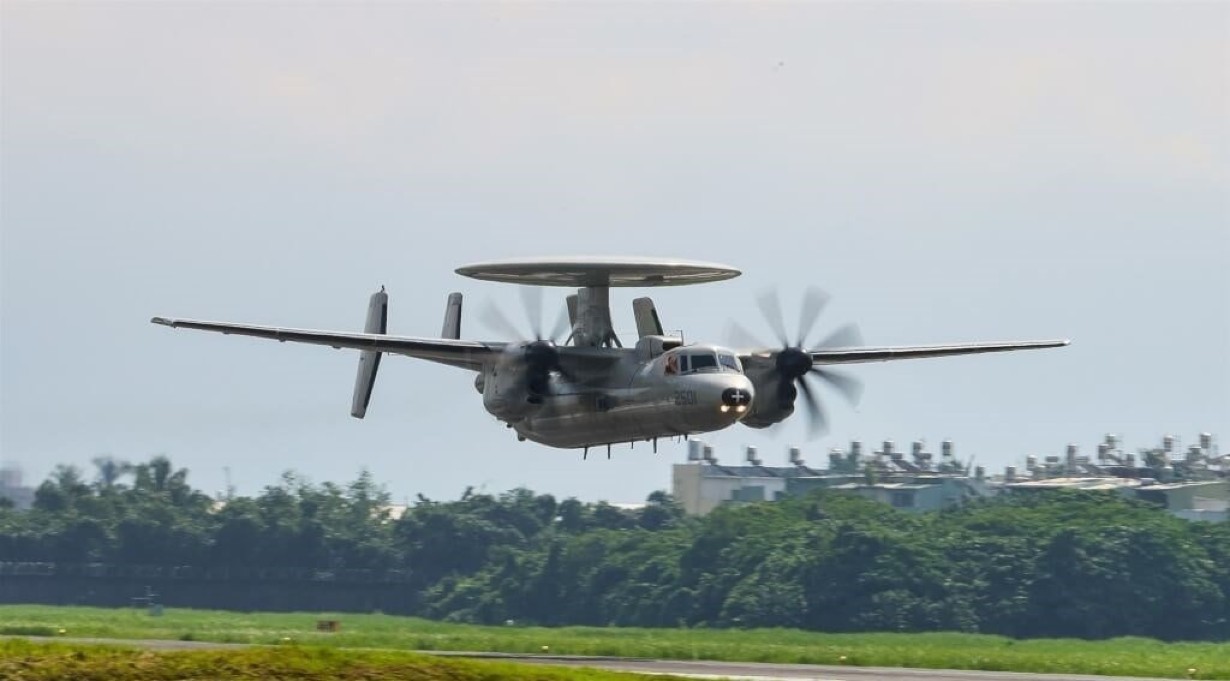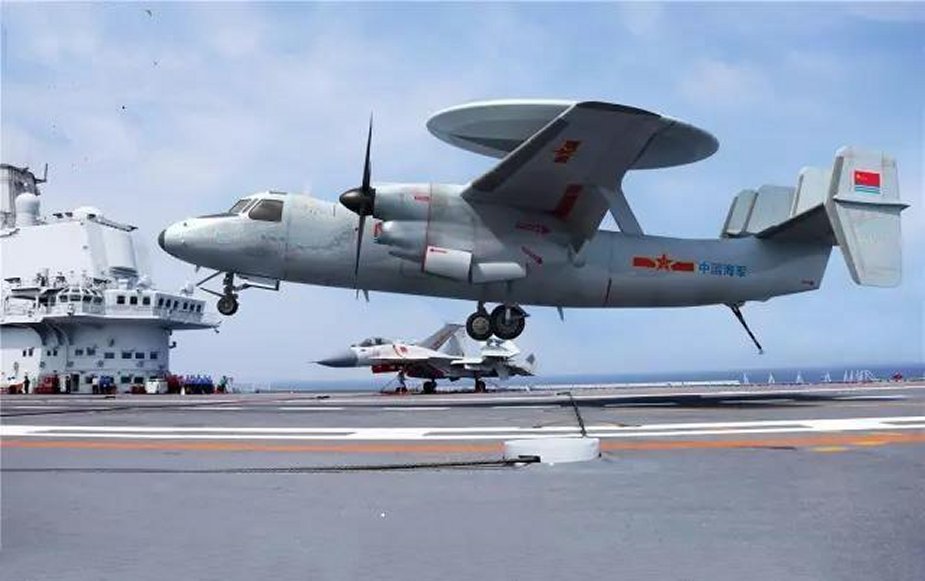After being accused of copying the design and technology of American stealth fighter jets like the F-22 and F-35, US experts have alleged that the Chinese twin-propeller, quad-tail, high-wing airborne early warning control aircraft is a copy of US Navy’s aircraft carrier-launched E-2D Hawkeye.
The Xi’an KJ-600 is designed to be deployed on Type 003 aircraft carriers and possibly on the Type 004 aircraft carriers of the People’s Liberation Army Navy. As of now, there is only one fixed-wing carrier-based AEWC in service in the world, the E-2 family, developed by the US company Northrop Grumman.
China’s development of the KJ-600 by Xi’an Aircraft Industrial Corporation as an aircraft carrier-launched Airborne Early Warning and Control system (AEW&C) is seen as an act of “copy-cat.”
The KJ-600 first flew in mid-2020.
The Chinese aircraft features a high-straight wing and is surmised to be powered by a pair of WJ-6 turboprop engines. It sports a quad-fin tailplane, tricycle gear, and a large dorsal rotodome suspected to be fitted with an AESA-type system.
In 2023, six KJ-600 prototypes were in different stages of testing. So far, there is no evidence that the aircraft has undergone catapult launch or arrested recovery at the land-based catapult test site at the PLA-Navy Carrier Aviation Test and Training Base.
While no one denies the possibility of the testing being done, the aircraft is on the verge of low-rate initial production. The timeline is congruous with the anticipated sea trials of the Fujian aircraft carrier (Type 003).
Fixed-wing carrier-borne AEW&C aircraft are crucial for any navy seeking a robust and capable carrier air wing. They enhance a carrier group’s offensive and defensive capabilities, situational awareness, and network-centric warfare. The KJ-600, once inducted, will be a significant asset for China’s naval aviation.
Kris Osborn, the President of Warrior Maven and a former Highly Qualified Expert at the Pentagon, argues: “In recent years, the People’s Liberation Army – Navy and Air Force have been maturing similar “Hawkeye-like” surveillance and warning planes such as the KJ-200 and KJ-500 aircraft. These efforts indicate a somewhat transparent or observable PLA effort to simply “replicate” “copy” or recreate the successful US Navy E-2D Hawkeye.”
PLA’s efforts to “replicate” or “hijack” US platforms and technologies have been a source of headache for Pentagon and American weapons developers. In recent years, the Chinese forces have also been emulating tactics, strategies, and doctrinal approaches on how best to integrate, apply, and deploy emerging technologies.
Many observers have noted the stark resemblance that the FC-31 has with the American F-35. The flat tail and twin engines of FC-31 seem to be derived from the F-22, and the front end resembles the F-35.
This doesn’t come as a surprise as a 2014 “U.S.-China Economic and Security Review Commission” Congressional report cited a Defense Science Board finding that Chinese cyber-attacks have siphoned off crucial specs and technical details of a range of US weapons systems—including the F-35.
Similarities between the Chinese KJ-600 and American E-2D Hawkeye
The Chinese KJ-600 and the US Navy E-2D Hawkeye are both AEW&C. The KJ-600 is a medium-sized early warning aircraft with two engines. Its primary role is surveillance, threat detection, and tracking.

The KJ-600 shares similarities with the US Navy’s E-2 Hawkeye series. The Chinese platform aims to achieve multi-domain, multi-platform joint connectivity, data transmission, and targeting.
The US experts feel the PLA has been maturing surveillance planes like the KJ-600 and is replicating the successful features of the E-2D Hawkeye, the American all-weather, carrier-capable tactical AEW aircraft.
The E-2 Hawkeye has the longest production run of any carrier-based aircraft, continuously producing variants since 1960. It replaced the earlier piston-engine E-1 Tracer. The E-2 has earned monikers like “Super Fudd” and “Hummer” for its distinctive turboprop engine sounds.

The Hawkeye, a surveillance aircraft, can also serve as a control and command center by networking with fighter jets, warships, drones, and even satellites in near real-time to draw a real-time battleground picture.
The experts feel that the PLA is trying to mirror the US tactics to meet the challenge that American forces pose. Emulating the US Navy, the PLA-Navy is integrating the KJ-600 with fighter jets. Recently, in an essay published in the Chinese-government-backed Global Times newspaper, China demonstrated the KJ-600’s capability to network with the J-15 carrier-launched fighter jet.
“During the drills, the early warning aircraft formed a communications network and established an information chain, detected and located target radiation sources, and commanded and guided the fighter jets to conduct attacks against targets at sea,” the Global Times states.
“The sensitivity, range, and fidelity of the PLA-Navy sensing, radar, and surveillance may or may not rival that of an upgraded US Navy Hawkeye, yet there does appear to be a PLA effort to replicate and copy-cat the US Navy in terms of design specs, technological configuration and concepts of operation,” Osborn added.
- Ritu Sharma has been a journalist for over a decade, writing on defense, foreign affairs, and nuclear technology.
- She can be reached at ritu.sharma (at) mail.com
- Follow EurAsian Times on Google News




